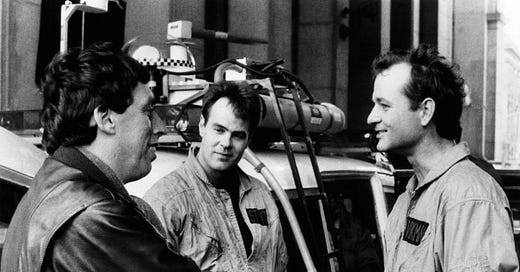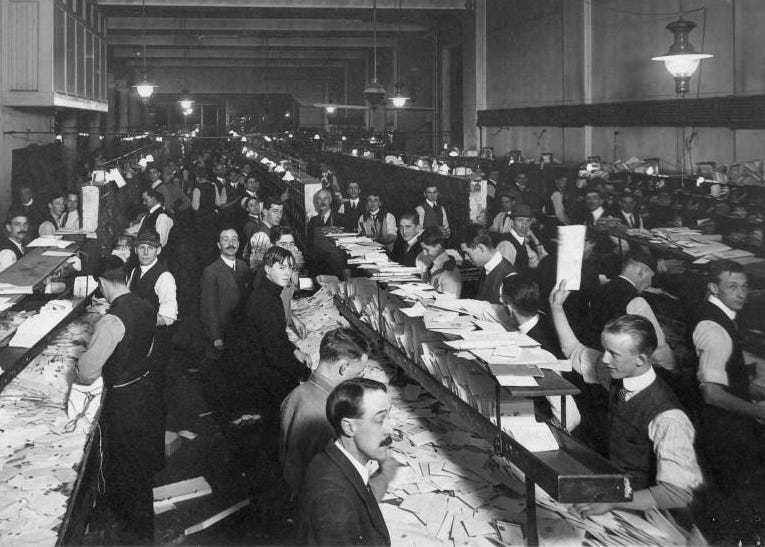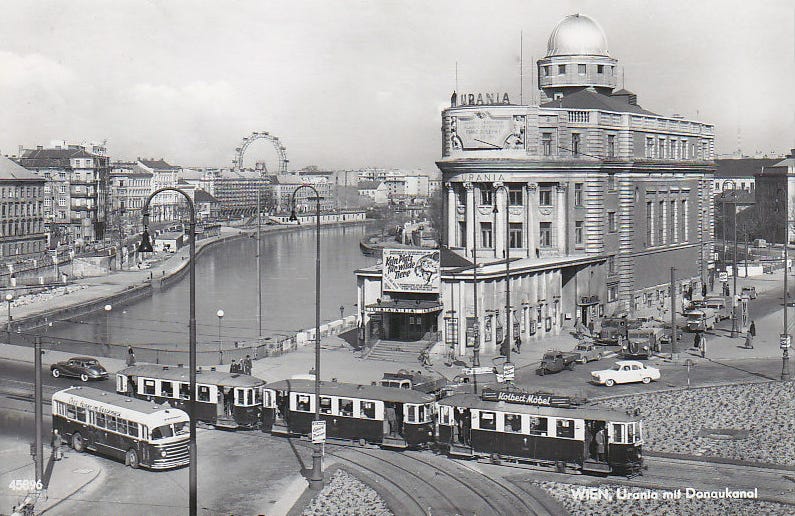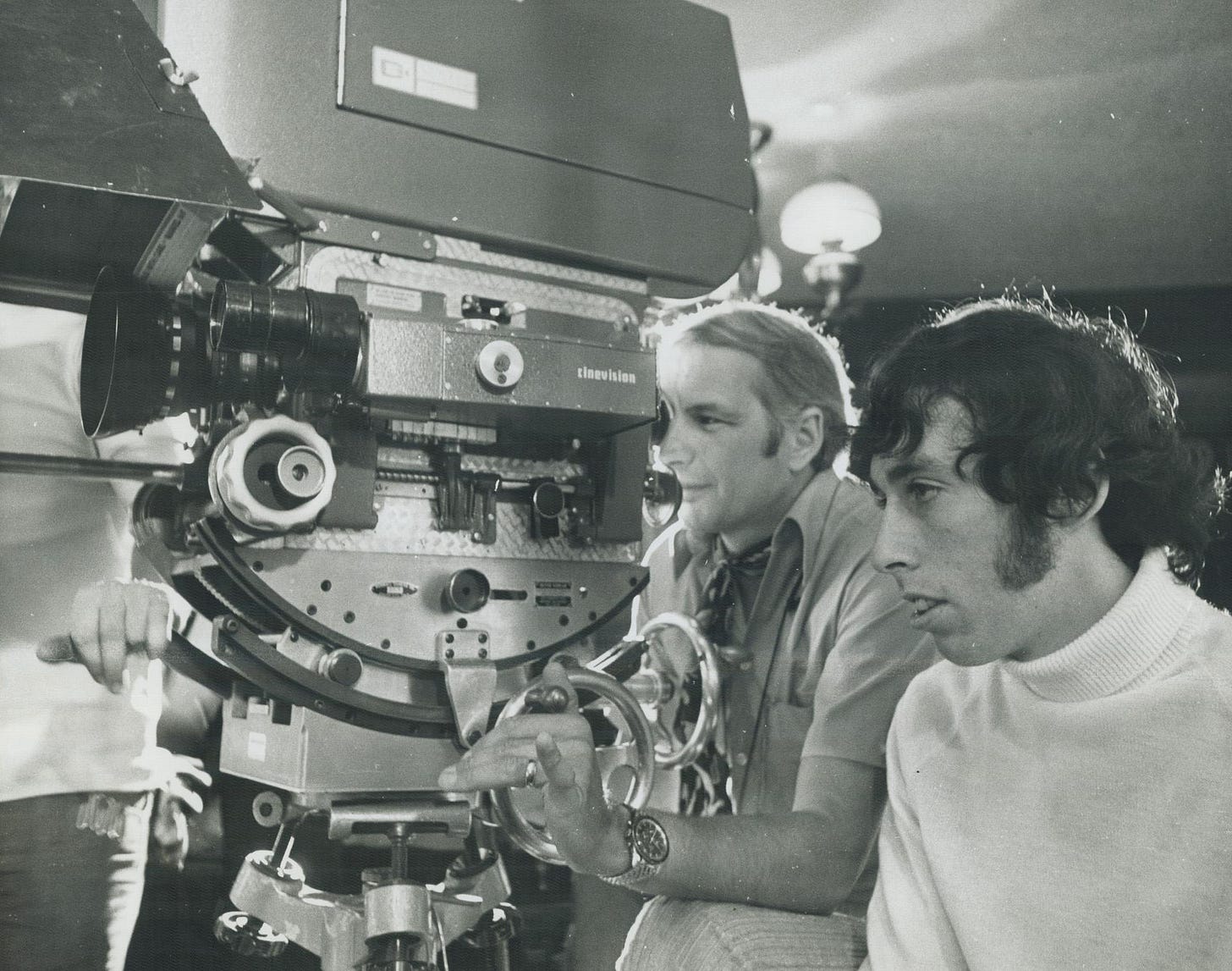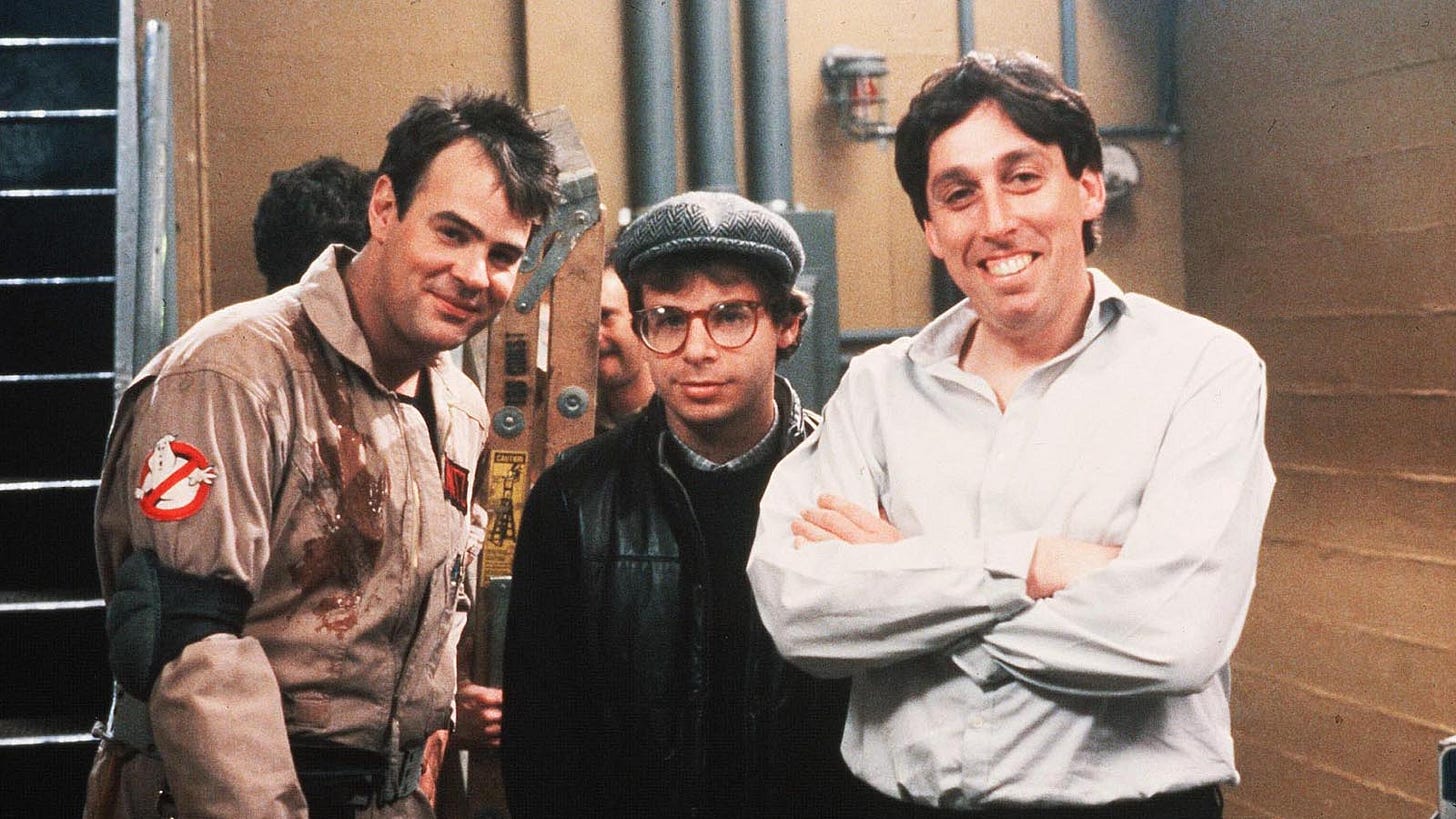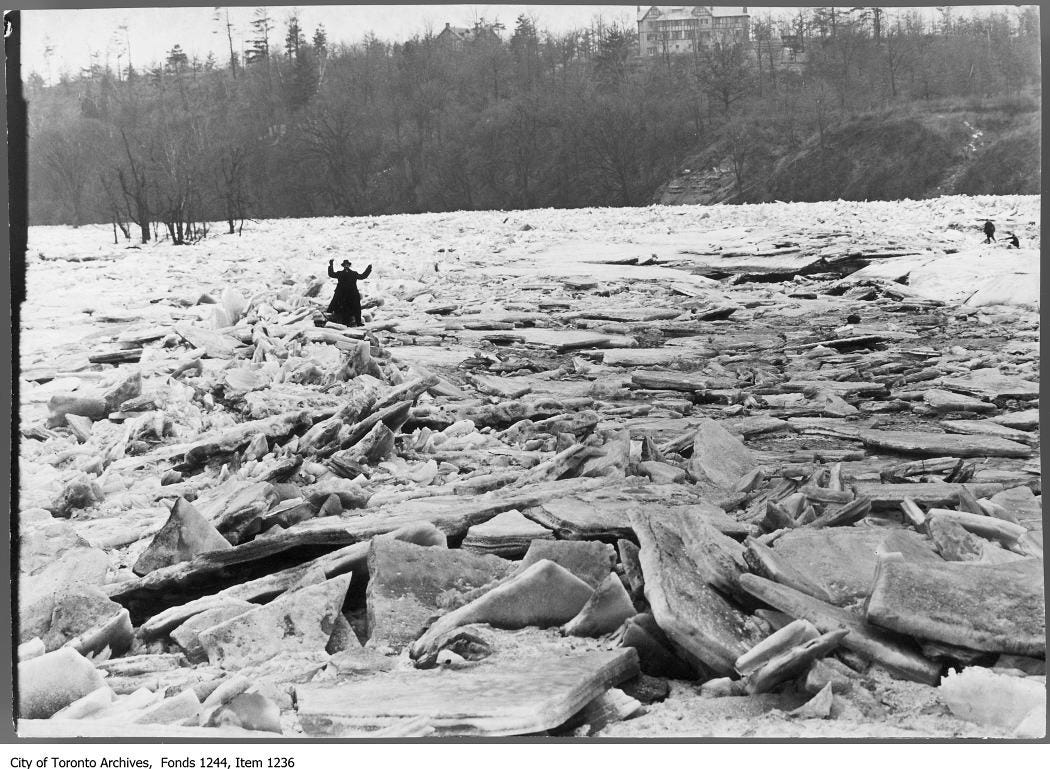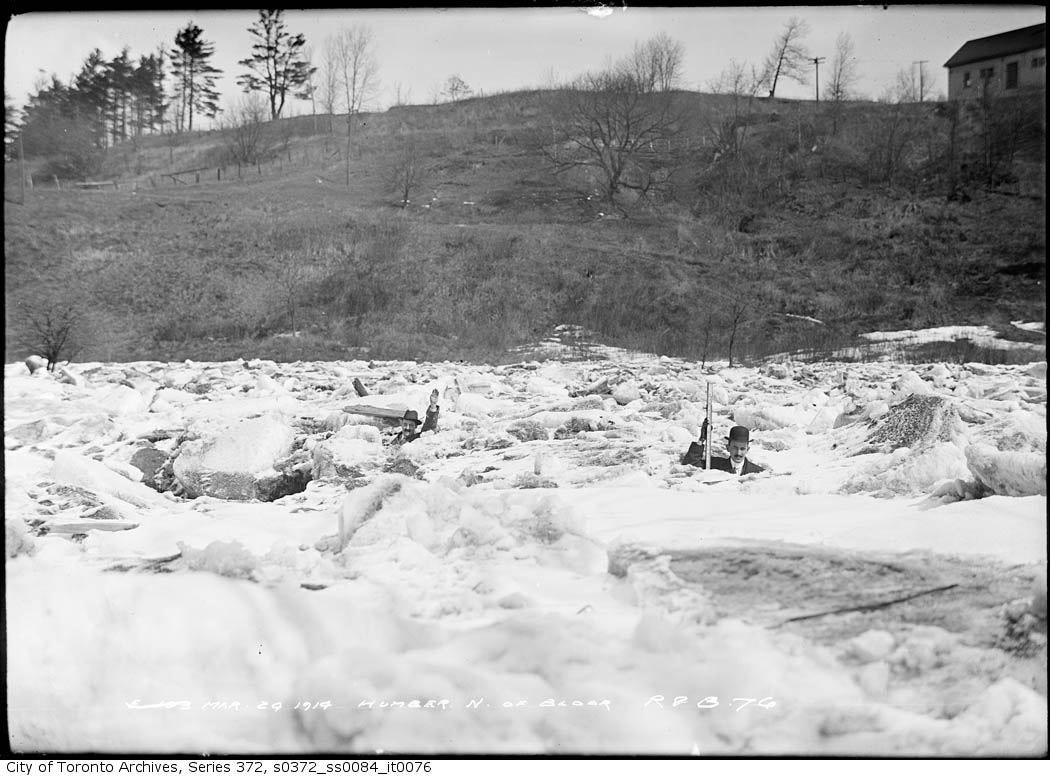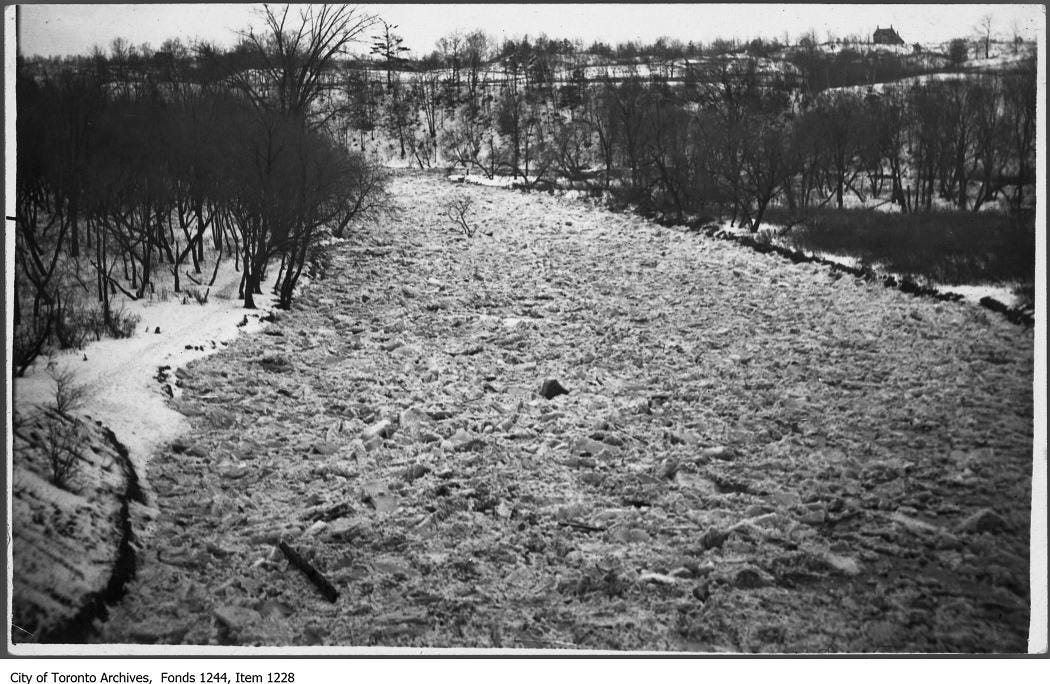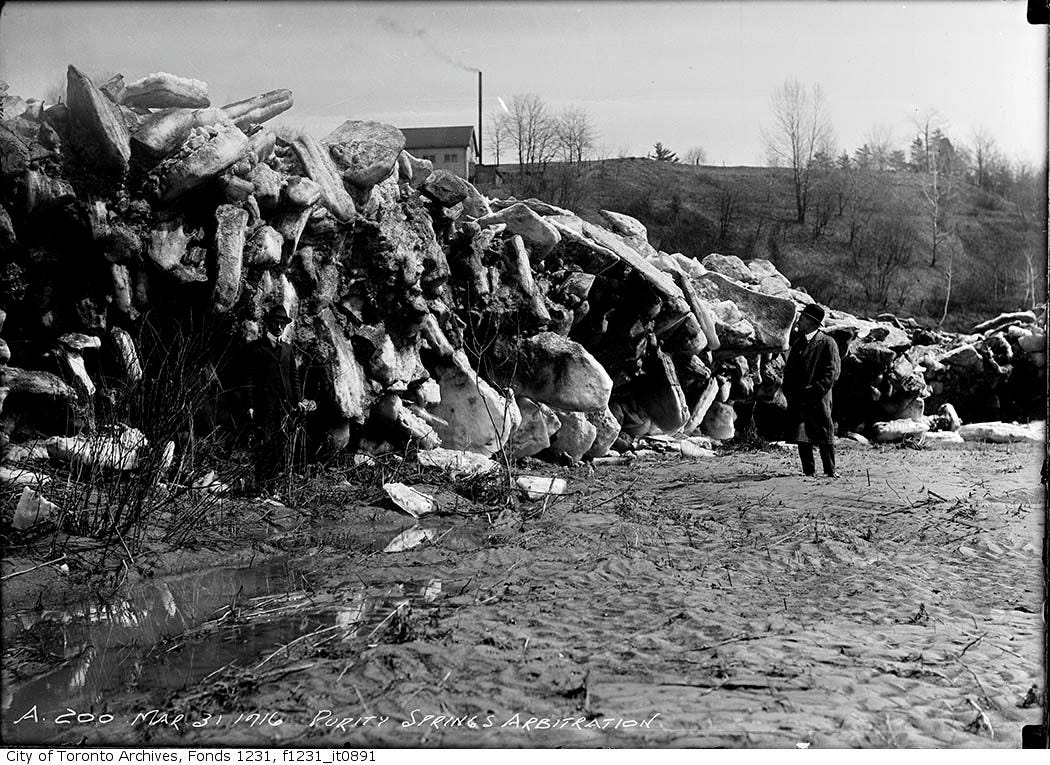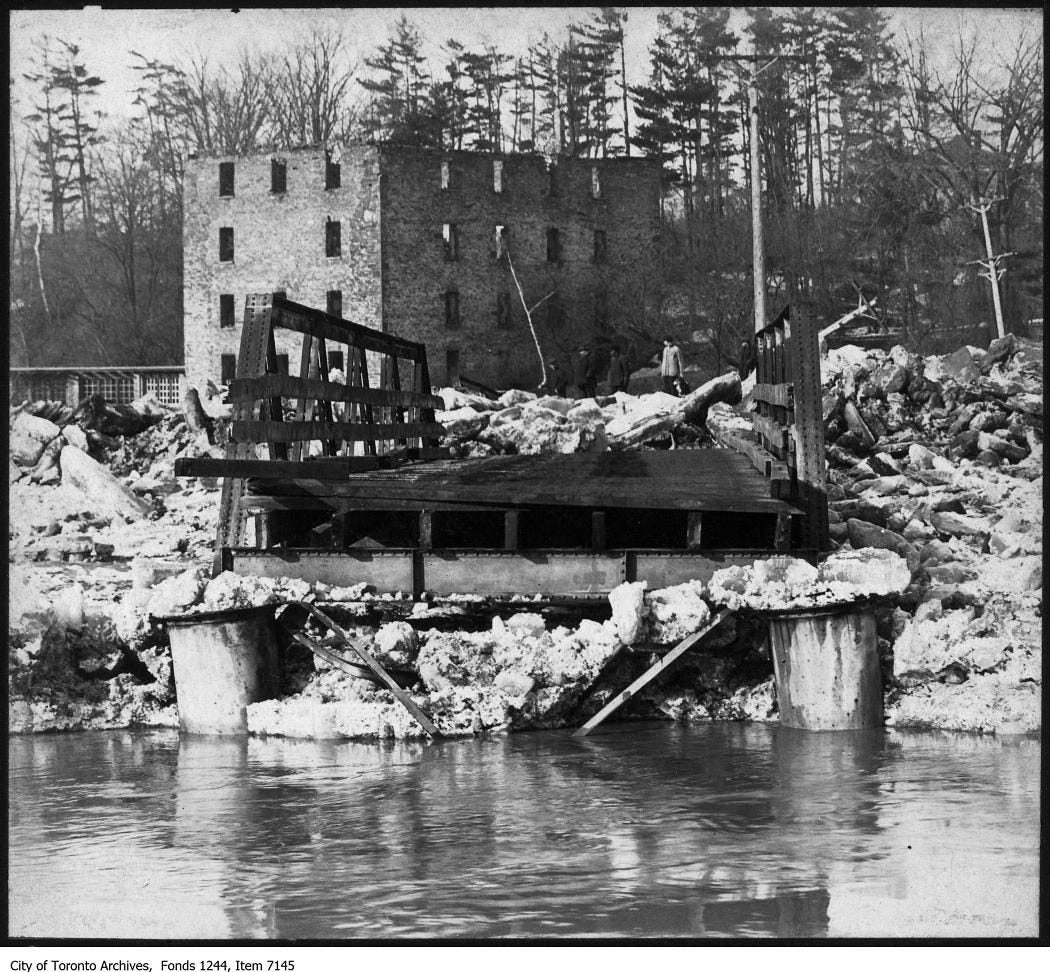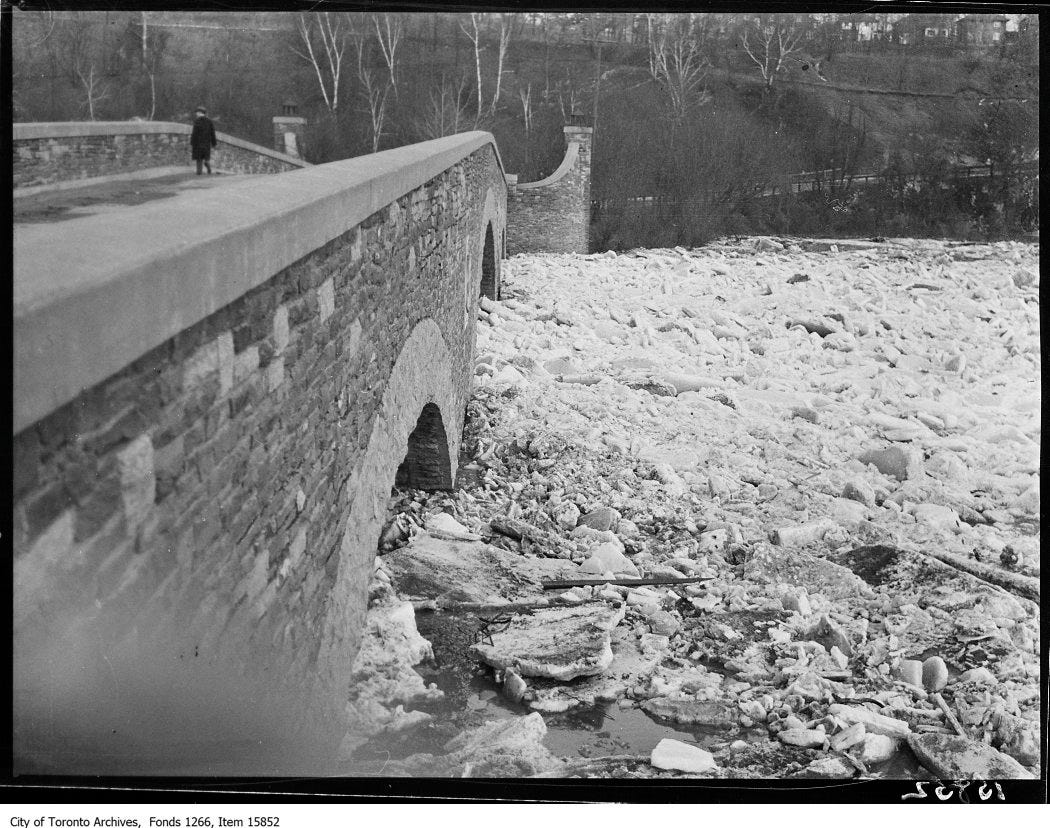I have big news! And it’s good news! I’ve decided that I’m going to keep offering The Toronto History Weekly for free. Hopefully, forever. But I need your help to make that possible.
I’m hoping that if you like my work and are able to afford it, you’ll switch to a paid subscription anyway. As it turns out, this newsletter is a quite a lot of work, so the only way I’ll be able to keep spending my time on it is if enough of you are willing to pay $5/month plus tax to keep it going.
Not only will I be eternally grateful to those of you who help this newsletter survive, I’m also planning to dream up some exclusive extras as a way of saying thank you to all the heroic paid subscribers, including free online talks — starting with one about the romantic history of the city that I’ll announce soon. Plus, you’ll be able to comment on the newsletter and ask questions. And you’ll be supporting all the work I do in sharing stories about the history of Toronto and Canada.
To switch to a paid subscription, just click here:
And for those of you who can’t, or would prefer not to, I totally understand! I’m absolutely thrilled to have you all as readers. So please do keep reading and spreading the word!
And on that note, we’ll begin this week’s edition of The Toronto History Weekly with the biggest, longest, wildest story I’ve shared in this newsletter so far…
THE STORY OF HOW BILL MURRAY NEARLY BECAME BATMAN IS ONE OF TORONTO’S MOST EPIC TALES
YOUR PARENTS WERE KILLED ON THE WAY HOME FROM THE OPERA NEWS — Our story begins in the town of Komárno, which stands on the banks of the Danube. The great river splits the small city in two: one half is in Slovakia; the other, called Komárom, is in Hungary. It’s a fascinating place that I’ve written about before because of its connection to one of the most extraordinary of all Torontonians. Komárno was Miriam Rosenthal’s hometown.
Rosenthal was a young Jewish woman living on the Slovakian side of town when the Second World War broke out, newly married and pregnant when the Nazis rounded her up and sent off her to Auschwitz. It was in a concentration camp that she gave birth to a baby boy who miraculously survived the horrors of the Holocaust. And when the war finally came to an end, the family left Europe to start a new life in Toronto. The store they opened here, Miriam’s Fine Judaica, stands on Bathurst Street to this day.
I devoted a whole chapter of The Toronto Book of Love to Rosenthal’s incredible story. But as it turns out, she isn’t the only notable Torontonian from Komárno. And the other one is much more famous.
It was just a year after the end of the war that Ivan Reitman was born on the very same side of town where Miriam Rosenthal grew up. His parents, too, were part of the city’s Jewish community and suffered terribly during the bloody years of the war. His father was a resistance fighter. His mother survived Auschwitz.
And things didn’t get much easier once the war ended. Just a few years later, while Reitman was still a toddler, Czechoslovakia’s parliamentary democracy was overthrown by a Communist coup, ushering in decades of authoritarian rule.
The Reitmans decided it was time to leave. Ivan’s mother bribed a tugboat captain to smuggle them out of the city. The family hid beneath the floorboards, which were nailed into place above them as the boat chugged up the Danube toward Vienna. Little Ivan was given sleeping pills to keep him quiet. “I was so knocked out that I slept with my eyes open,” he’d later remember. “My parents were afraid I was dead.”
It was five long days later that they finally arrived in the Austrian capital. The floorboards were pried back up. The family was free.
That’s how Ivan Reitman ended up in Toronto, as a refugee. He lived above his family’s dry-cleaning shop on Avenue Road and went to Oakwood Collegiate — that’s where he started a high school folk band, playing the coffeehouses of Yorkville at the height of the 1960s scene.
At first, it looked like music would be Ivan’s future. That’s what he studied at McMaster University. But his dream was to compose movie scores and there at university he really started to get into film. His classmates included the likes of Martin Short, Eugene Levy and Dave Thomas. Before long, Reitman was the head of the McMaster Film Board and beginning to make his first student films.
He’d always loved movies. His favourite toy as a boy was a slide projector that showed still images from Disney cartoons. He’d even tried to take it with him as his family made their dramatic escape from Komárno, a toddler vainly trying to shove an entire slide projector into his suitcase before his parents made him leave it behind. And the kind of films he made as a young man seem to have been deeply influenced by the long days he spent hiding beneath the floorboards on that tugboat on the Danube.
“You have to know one thing,'' his dad once told The Washington Post. ''We were five days in that boat. It was very hard on him. This affects a child. Maybe what he missed as a very young child, this is what he wanted to recapture in high school and college — the crazy stuff.''
Reitman’s first student film has been called “the most successful student film ever made in Canada.” It got a theatrical release, playing in local Toronto cinemas as a short shown before a Dustin Hoffman/Mia Farrow movie. His second film, on the other hand, would instantly make him one of the most notorious filmmakers in the city.
The Columbus of Sex was basically a soft-core flick based on a 4,000 page anonymous Victorian sexual memoir that’s been called “one of the strangest and most obsessive books ever written.” The film was quickly seized by police and Reitman found himself on trial for obscenity.
The court case made front page news. And despite a spirited defence that included testimony from Pierre Berton arguing in favour of the film’s artistic merits, Reitman was convicted, fined, and put on parole. The Columbus of Sex became the first Canadian film ever banned by the Ontario Board of Censors.
Many of Reitman’s early movies would be raunchy, boundary-pushing affairs. Take Cannibal Girls, which starred Eugene Levy and Andrea Martin and was about exactly what it sounds like it was about…
Then there was Orgy of the Blood Parasites, which would spark its own massive national controversy.
It was produced by Reitman and renamed Shivers before its release. It was David Cronenberg’s third film. And as you’d expect from Cronenberg, it combined sex and violence in a way that was deeply shocking to many Canadians in the 1970s — especially since it got public funding from Telefilm (called the Canadian Film Development Corporation back then).
Respected Canadian film critic Robert Fulford denounced the film as "the most repulsive movie I've ever seen… an atrocity, a disgrace to everyone connected with it — including the taxpayers.” He claimed it was so shockingly awful that Canada might not deserve to make movies at all anymore. “If using public money to produce films like this is the only way that English Canada can have a film industry, then perhaps English Canada should not have a film industry.”
Shivers was debated in the House of Commons. David Cronenberg’s landlady kicked him out of his Toronto apartment over it. But it also became one of the highest grossing films Canada had ever produced (the first one that ever made Telefilm’s money back) and has a 85% rating on Rotten Tomatoes.
Still, it was clear conservative Canada wasn’t ready for it. With his reputation north of the border taking a beating, Reitman would shift his focus south to the United States. And his raunchy Canadian horror roots would inform the raunchy American comedies to come.
It was a show at the El Mocambo that sparked the big shift. That’s where Reitman saw National Lampoon’s live show, Lemmings. It starred John Belushi, Chevy Chase, Christopher Guest and Zal Yanovsky (the Toronto guitarist of The Lovin’ Spoonful, who has now weirdly popped up in this newsletter three weeks running). Reitman was so impressed, he soon talked his way into producing another one of National Lampoon’s live shows.
Reitman did have experience producing for the stage. He’d worked on Spellbound, a rock music/magic show starring another one of his old McMaster classmates: the magician Doug Henning, who would later become famous for bringing the Natural Law Party to Canada, running on a platform dedicated to "the principles of Transcendental Meditation." The show was written by Cronenberg, featured music by Paul Shaffer and Howard Shore, opened at the Royal Alex, moved to Broadway, and won the Tony for Best Musical.
But movie theatres are where Reitman’s partnership with National Lampoon would really pay off. Together, they made Animal House — one of the most successful comedies of all-time.
The hits came quick after that — whether Reitman was serving as a producer or a director. Over the next two decades, he would make Twins, Stripes, Kindergarten Cop, Legal Eagles, Dave, Space Jam and, of course, Ghostbusters.
Ivan Reitman and Bill Murray had been working together for years — Reitman was the first director to hire Murray for a big film role when he cast him in Meatballs, a movie inspired by the Ontario summer camps of Reitman’s youth and filmed at a camp in Haliburton.
Ghostbusters was their biggest hit yet — co-starring another old friend of Reitman’s: Dan Aykroyd, who he’d met early in his career, during a brief stint working at CITY-TV before quickly being fired by Moses Znaimer.
Ghostbusters smashed box office records, making more money than any comedy ever had. It became a cultural phenomenon, spawned a multimedia franchise, and has been preserved by the Library of Congress among the greatest American films of all-time. Even the theme song was a #1 hit.
It was so big, in fact, that its director was asked to make a superhero movie. Ivan Reitman was going to direct Batman.
His vision was very different from the moody Batman films of today. In keeping with Reitman’s comedy experience, it would be a much lighter take on the superhero. Bill Murray would play the caped crusaders. His sidekick Robin would be played by Eddie Murphy. The villainous Joker would be David Bowie.
It promised to be amazing. But we’ll never really know how it would have turned out. As delays mounted up, Reitman moved on to other projects. And Batman eventually evolved into the much darker Tim Burton film that eventually did get made.
One writer has called the loss of a Bill Murray Batman “perhaps the greatest disappointment in popular film history.”
But none of it slowed Reitman down. While Batman never happened, the Torontonian carried on having success throughout his career — even landing a Best Picture Oscar nomination for Up The Air. He kept making movies for the rest of his life, before passing away last weekend at the age of 75.
And Ivan Reitman’s legacy in Toronto isn’t limited to the silver screen. He has also left a physical mark on our city’s skyline, one that will be with us for decades — maybe even centuries — to come.
The dry-cleaners on Avenue Road wasn’t the only business the Reitmans owned. Ivan’s dad also bought a carwash. Farb’s Car Wash stood right downtown — on the corner of King & John. At the time, it was an industrial part of town, but that corner would soon prove to be a very valuable piece of real estate. The neighbourhood was going to be transformed as Honest Ed Mirvish moved in, opening restaurants and theatres, turning that stretch of King Street into the Entertainment District we know today. Reitman’s dad turned the carwash into a parking lot to serve the theatre-goers and diners that began flooding in. And as property values skyrocketed, he decided to sell the land and make a tidy profit.
That’s when his son stepped in. Ivan Reitman used some of the money he’d made from Animal House to keep the land in the family, waiting for an even bigger opportunity. And that opportunity would come in the early 2000s.
When the Toronto Film Festival revealed it was looking for a new home, Reitman had just the place for them. “I always had this close relationship with the film festival,” he later told The Toronto Sun. “And after my parents passed away, my sisters and I wanted to find a way to memorialize their extraordinary love story — World War II and through Communist Czechoslovakia, this wonderful immigrant story, which was also my story, because I escaped with them to Toronto.”
He donated the land where his father’s carwash once stood, giving it to the film festival as a place to build their new home. “I always wanted to do something for the city,” Reitman explained, “and what could be better?”
So today, as the Lightbox soars above King Street, it’s not only one of the most special places to watch movies in Toronto — it’s also a towering testament to the story of the Reitmans, to a resistance fighter and a woman who survived Auschwitz, to their escape from Komárno and those five days hidden under the floorboards of a tugboat, to their son’s raunchy horrors flicks, the ones banned and denounced as obscenities, and to the beloved comedies and summer camp romps and ghost-fighting heroes that followed.
It’s even, if you squint just a little bit, a monument to the film that never got made. The one that would have seen Bill Murray in tights.
Just a little reminder that you can keep this newsletter going by switching to a paid subscription.
THE ICE OF THE HUMBER RIVER
FROZEN NEWS — The Humber River has been making headlines this week. The frozen waterway has begun thawing a bit with the warmer weather, which means the ice has been breaking into enormous chunks. They’ve clogged the river, overspilled its banks, and caused flooding. And that has reminded me of some of my favourite old photos of the Humber.
Ice jams have been a problem on the river for at least 200 years, since the days when the first British settlers arrived and began changing ancient patterns of life. As mills were built and the banks deforested, floods became an increasing danger in the warmer months. And at the end of the winter, the power of the breaking ice could destroy dams and wipe out bridges.
You can see just how physically big the problem was in my very favourite photo of the ice. It’s from 1914. The heads and shoulders of two men are barely even visible as they stand in the middle of the jam:
The Old Mill Bridge had nearly succumbed to the ice that year. And two years later, it would. It was the most recent in a series of bridges that had spanned the river at that spot since the 1830s. For nearly 200 years, those bridges were the primary way to cross the Humber near Bloor Street. And this one was made of steel. But it was no match for the ice that filled the river in the spring of 1916.
Lots of the icy old photos you’ll find in the City of Toronto Archives are from that notorious March. Many of them look exactly like the new ones making the rounds on social media this week, a reminder of the natural power of the place we call home and of forces that will outlive us all…
The bridge couldn’t stand up against the barrage of ice that slammed into it that month. Thousands of tons of frozen water piled up against it. It groaned and flooded and eventually gave way entirely:
A group of gawking spectators who’d gathered on the bridge to watch were lucky to escape with their lives when it broke. Two of them were swept downstream, barely able to grab a tree limb to keep themselves from drowning in the frigid torrent.
With the old bridge gone, a new bridge would have to be built. This time, it was made of concrete and stone, stronger than any that had come before it. It has seen more than a hundred winters since then, plus raging storms, even a hurricane, and has stood up against them all.
Read more about the ice flows of 1916 from Torontoist’s David Wencer.
QUICK LINKS
Everything else that’s new in Toronto’s past…
MARTIAL LAW NEWS — With the federal government invoking the Emergencies Act for the first time in history, Jamie Bradburn has shared an old article he wrote about its predecessor — the War Measures Act — and the impact it had on Toronto when it was last brought into force during the FLQ crisis. Read more.
TORONTO’S OLDEST HOUSE NEWS — blogTO ventured inside John Cox Cottage this week, thought to be the oldest house in Toronto that’s still being used as a house. Originally a simple log cabin, it might have been built in the late 1700s or very early 1800s. Read more.
BLACK HISTORY POSTER NEWS — The City of Toronto has teamed up with local artists to create a series of posters profiling Black residents from Canada’s past, like activist Viola Desmond and inventor Elijah McCoy. They’re currently on display at hockey rinks in parks around the city. Read more.
BLACK HISTORY JUDGE NEWS — Global News profiles George E. Carter, the Toronto lawyer who became the first Black judge in Canada IN 1980! Read more.
HISTORY BLOG NEWS — A couple of weeks ago, I mentioned Katherine Taylor’s new book, Toronto City of Commerce. She’s also been writing a Toronto history blog for years, One Gal’s Toronto, and Global News interviewed her about it this week. Watch it.
NUCLEAR APOCALYPSE NEWS — Toronto is home to a few old air raid sirens left over from the Cold War, still hidden around the city in plain sight. There’s even one just outside Trinity Bellwoods Park. Read more.
TORONTO HISTORY EVENTS
MASSEY HALL: LISTEN TO THE FASCINATING STORY OF CANADA’S MOST TREASURED CONCERT HALL
February 22 — 9:30, 10:30 and 11:30am — Online — Riverdale Historical Society
Join David McPherson, author of the new book, Massey Hall, for an online talk about the venue’s history. “Known for its intimacy and sense of occasion, a night at Toronto’s Massey Hall is magical for both audiences and performers… Looking out over the crowd, performers often comment that they feel they have joined history as they stand on the stage where Sarah Vaughan, Miles Davis, Bob Dylan, and so many other legends have stood.”
Free, I believe, if you join the Riverdale Historical Society mailing list.
LYTTON PARK: HISTORY OF A COMMUNITY, 1886–WWI
February 23 — 7:30pm — Online — North Toronto Historical Society
“Eli Aaron will cover the history of Lytton Park, tracing the development of the community from the arrival of the radial line in 1886 through the subsequent subdivision of farms into the streets we know today. His illustrated presentation examines the area between Yonge Street and Avenue Road from the 1880s to the 1930s with a focus on architecture and early community residents.
“NOTE: A brief Annual General Meeting will precede this program.”
Free for members of the North Toronto Historical Society, I think, and an annual membership costs $7.
A VIRTUAL FIELD TRIP TO MACKENZIE HOUSE
February 24 — 9:30, 10:30 and 11:30am — Online — Toronto Historic Sites & the AGO
“In this session we explore the Power of the Press and the story of Mary Ann Shadd. Mary Ann was the first Black woman in North America to publish a newspaper, The Provincial Freeman. Her newspaper fought for the abolition of slavery and the rights of women and helped people escaping enslavement adjust to life in Ontario. In Mary Ann’s words, she had ‘broken the editorial ice.’ She hoped her example would inspire more Black women to write and publish.”
This is part of the AGO’s Virtual Schools program. It looks like the 9:30 session is for kids JK–Grade 3, the 10:30 session for Grades 4–8, and 11:30 for Grades 9–12.
Free!
1851: SPIRIT & VOICE
February 24 — 7pm — Online — Myseum
“A theatrical and playful revisiting of the 1851 North American Convention of Coloured Freemen. Through this new work written by playwright Luke Reece, step into the world of a fictionalized digital conference where the past and present collide.
“Live from St. Lawrence Hall, Marie and Anthony host a retrospective look at the gathering of 19th century abolitionists in Toronto, when their event is crashed by ghosts of conventions past. Together our characters grapple with the way history has been written, as well as issues that affect Black lives today. Watch leading historical figures Mary Ann Shadd Cary, Henry and Mary Bibb, and Frederick Douglass share their unfiltered thoughts on historical storytelling and 21st century anti-Black racism.”
Free with registration.

